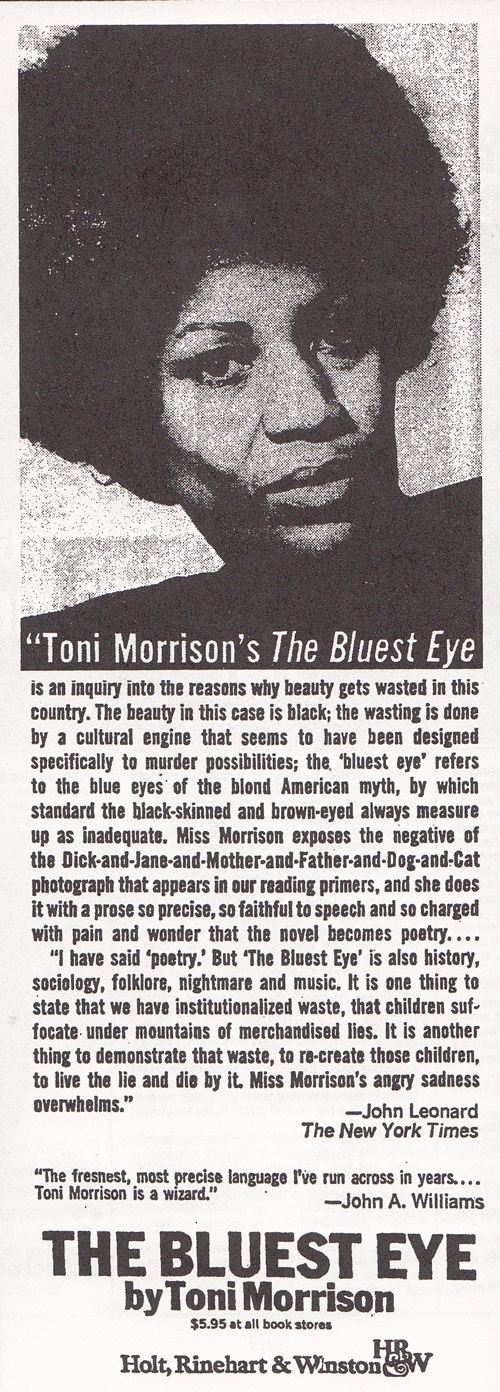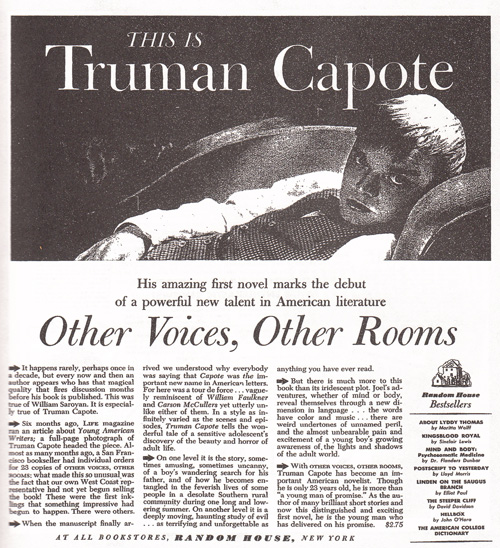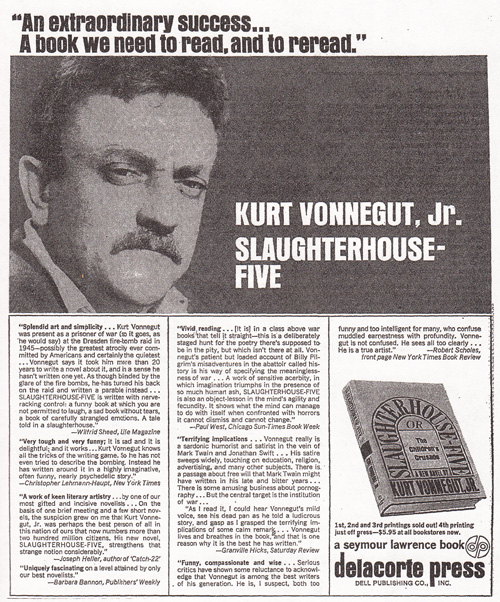Monday, October 1, 2012
Friday, September 28, 2012
First Line Friday: Dialogue
“Mrs. Dalloway said she would buy the flowers herself.”
Wait,
what? Who is Mrs. Dalloway? Who’s she talking to? And what is it
she buying flowers for ? All great
questions, and all great reasons for the reader to read further. By starting
Mrs. Dalloway in the middle of things, Virginia Woolf forces the reader to snap to attention.
We feel like we’re one step behind and we’d better pull ourselves together if
we’re going to make heads or tails of the story.
It’s kind of counterintuitive,
but when we're forced to cut to the chase we become highly attuned to the
character descriptions, background details and other exposition that she’ll
dole out as the story unfolds- probably even moreso than if we picked up the
same story to read “Mrs. Dalloway was self-conscious about her role in London
high society, blah, blah, blah…”
Here
are some other examples of novels whose characters come out of the gates
blabbering:
“—Money . . . in a voice that rustled.” (William Gaddis, J R )
You better not never tell nobody but God. (Alice Walker, The Color Purple )
"To be born again," sang Gibreel Farishta tumbling from the heavens, "first you have to die." (Salman Rushdie, The Satanic Verses )
"Take my camel, dear," said my Aunt Dot, as she climbed down from this animal on her return from High Mass. (Rose Macaulay, The Towers of Trebizond )
"When your mama was the geek, my dreamlets," Papa would say, "she made the nipping off of noggins such a crystal mystery that the hens themselves yearned toward her, waltzing around her, hypnotized with longing." (Katherine Dunn, Geek Love )
I’m
actually surprised this isn’t used more than it is. My guess is that people
think it’s a gimmick, but I think it’s pretty darned effective. You?
Labels:
Alice Walker,
First Lines,
Katherine Dunn,
Rose Macauley,
Salman Rushdie,
Virginia Woolf,
William Gaddis
Thursday, September 27, 2012
Author Look-Alikes Vol. 7
Last
time we did this, some of you might have felt that my comparison of David
Foster Wallace to the Karate Kid was a little forced. Well, just try to tell me
I’m stretching with this one. Young DFW and a young Ben Affleck:
Dark
hair, slim face, deep-set eyes, how about Joyce Carol Oates and "The Shining"-era Shelly Duvall?
Or
Hermann Hesse and the Nazi from Indiana Jones and the Last Crusade? (Insert your own Arian race joke here):
And
for an interesting twist, how about a writer that looks like another writer? I
give you Dashiell Hammett and William Faulkner (cross reference with William
Faulkner and Dashiell Hammett). The only discernible difference between them is that one uses mustache wax, and the other uses a Flowbee:
Finally,
this will be seen as unkind, but I can only call them like I see them. I think
an aging Isak Dinesen, AKA Karen Blixen, is a dead ringer for Margaret
Hamilton, AKA the Wicked Witch of the West:
I’ll
get you, my pretty... at the foot of the Ngong Hills.
Labels:
Author Look-Alikes,
Dashiell Hammett,
David Foster Wallace,
Faulkner,
Hermann Hesse,
Isak Dinesen,
Joyce Carol Oates
Wednesday, September 26, 2012
What Bugs Me Wednesday: Fogg's Non-existent Airship
It has occurred to me that I’m missing out on one of the major perks of having a forum for my own personal ramblings: the opportunity to complain about stuff that bugs me.
So here is the first of what will be a sporadic feature- after all, not a lot of stuff really bugs me- that we’ll call “What Bugs Me Wednesday.”
We begin the series with one of literature’s greatest and longest-lasting lies: the mythical airship in Jules Verne’s Around the World In 80 Days. Just about every film adaptation, comic book version and dumbed-down retelling has invented some sort of hot-air balloon out of whole cloth (pardon the pun). Even the cover art for reprintings of Verne’s classic is guilty from time to time. Sometimes it’s a zeppelin, sometimes it’s a steampunk airship, but whatever form it takes, it has no relation whatsoever to the story as Verne wrote it.
The incomparable Phileas Fogg and his valet Passpartout do indeed set out on a memorable adventure. They have run-ins with the law, with outlaws, with vigilantes and religious sects. There’s a princess in distress, an opium-den trap and an acrobatic circus. Modes of transportation are rented, bought, hijacked and destroyed, but at no point in the journey do the characters take to the air.
Do they take a turn on the back of an elephant? Sure. Do they cross the Great Plains in a fortuitous windsled? They do. But do they ever set foot in the basket of a hot-air balloon? No, no, a thousand times no. And it’s time for this nonsense to stop.
Pictured above are the thumbnails from the first page of Google Image results for “Around the World in 80 Days.” Take a quick look and you can see how widespread this pernicious falsehood has become. An entire generation is being led to believe that Fogg was some sort of Victorian Steve Fossett. And yeah, it kind of bugs me.
Tuesday, September 25, 2012
Some Autumn Reading
I rarely read
anything twice, much less three or four times. There are just too many good books
waiting in the hopper.
But when fall temperatures
begin to dip, and the leaves start to signal that they’ve felt it, too, I sometimes
find myself pulling a tiny, almost forgotten book down off my shelf.
Thinner than my
wallet, and not much taller or wider, it contains just two stories: Rip Van Winkle and The Legend of Sleepy Hollow, by Washington Irving. It’s a ‘Penguin
60’- part of a collection Penguin released to celebrate their 60th
anniversary in 1995.
I don’t do this
every year, but I’ve dusted it off a handful of times in the decade and a half
I’ve owned it– at least as often as some people pick up A Christmas Carol in the run up to the holidays. I find it’s the
perfect lead-in to fall, and a nice way to set the stage for Halloween. As you
can see below, it would be hard to ‘out-autumn’ Irving when he’s really going
for it. First, from Rip Van Winkle :
“It was, as I have said, a fine autumnal day, the sky was clear and serene, and nature wore that rich and golden livery which we always associate with the idea of abundance. The forests had put on their sober brown and yellow, while some trees of the tenderer kind had been nipped by the frosts into brilliant dyes of orange, purple, and scarlet. Streaming files of wild ducks began to make their appearance high in the air; the bark of the squirrel might be heard from the groves of beech and hickory nuts, and the pensive whistle of the quail at intervals from the neighboring stubble-field…”
And then this, from The Legend of Sleepy Hollow :
“As Ichabod jogged slowly on his way, his eye, ever open to every symptom of culinary abundance, ranged with delight over the treasures of jolly autumn. On all sides he beheld vast stores of apples; some hanging in oppressive opulence on the trees; some gathered into baskets and barrels for the market; others heaped up in rich piles for the cider-press. Farther on he beheld great fields of Indian corn, with its golden ears peeping from their leafy coverts, and holding out the promise of cakes and hasty pudding; and the yellow pumpkins lying beneath them, turning up their fair round bellies to the sun, and giving ample prospects of the most luxurious of pies; and anon he passed the fragrant buckwheat fields, breathing the odor of the beehive, and as he beheld them, soft anticipations stole over his mind of dainty slapjacks, well buttered, and garnished with honey or treacle, by the delicate little dimpled hand of Katrina Van Tassel.”
Taken together, both stories are just shy of
20,000 words. If you’re looking for a light, autumnal diversion, I highly recommend
checking them out.
What other books or stories help you set the
stage for fall?
Monday, September 24, 2012
Review: Moby Dick, by Herman Melville
Alright,
so, Moby Dick!
I
mentioned here how ecstatic I was to finally harpoon the great white whale that
has taunted me ever since 7th grade English. And now it’s time to actually
review the son-of-a-gun.
The
last thing I was expecting from this bad boy was that it would be laugh out
loud funny in parts, yet there I was, just a few pages in, and our narrator Ishmael
finds himself apoplectic that he has to share a bed with a heathenistic, cannibal
harpooneer, who against all odds becomes his best friend and shipmate. And Stub,
good grief! I could listen to the Pequod’s second mate talk to his crew all day
long. The man’s hilarious.
But
the book is more than just colorful. Melville builds mystery and bad omens into
the story from the beginning. The reader goes to sea with the same reservations
about the ship and its captain as Ishmael. It’s a well-spun yarn.
Now,
the most frequent criticism I’ve heard of Moby Dick is that it’s cumbersome.
Not just that it’s long, but that it’s full of meaningless tangential
information that doesn’t move the story forward. But after reading it, I’m
convinced that people who say this suffer from a general lack of curiosity.
Does
he dedicate entire sections of the book to whale taxonomy? Sure he does. Does
he mention every piece of art, and list every literary reference that touches
on whales, sea monsters and “leviathans” of all orders? You bet. Does he painstakingly
document the notorious generosity of
English and Dutch ships to other ships in the whaling trade, and uncover the
origin of the “crow’s nest” that adorned the ships of his day? Absolutely. But my question is, why don’t you want to know about
all of that? It interesting stuff.
If
you’re like me, you’re helplessly drawn to Wikipedia by any book you read-
fiction or non-fiction- because they open up new ideas, teach you new things and
fill in your paltry knowledge of the world around you. But hey, guess what, I
didn’t have to do that with Moby Dick
because Melville already did it for me.
His tangents were my tangents, his obscure whaling trivia, my obscure whaling
trivia. If that’s not your thing, bless your bored little heart.
Now,
I do have plenty of my own criticisms. How Ishmael forges a bond, and goes to
sea with Queequeg, and then fails to mention him for nearly the remainder of
the book. How he jumps from head to head like an omniscient narrator, even
though he’s just one of the shiphands. How the Pequod was able to track down
and encounter a single, solitary whale in the vast natural range of his species.
(Just take a look at that map- the blue isn’t just ocean, it’s the almost
limitless habitat of the sperm whale. Talk about a finding needle in a haystack!)
So yes, there were plenty of problems. And
yet… I enjoyed the hell out of it. It was a very pleasant surprise.
Friday, September 21, 2012
First Line Friday: Axioms
Last
week we covered first lines that set settings. This week, we pay tribute to the
axiomatic opening. Here’s a well-known example that many will recognize:
“It is a truth universally acknowledged, that a single man in possession of a good fortune, must be in want of a wife.” — from Jane Austen’s Pride and Prejudice
Want
another? How about this one- equally as famous as the first:
“Happy families are all alike; every unhappy family is unhappy in its own way.” —from Leo Tolstoy’s Anna Karenina
These
adages can be sarcastic, like Austen’s, or introduce a kind of a farcical
situation, like Tolstoy’s. Or they can be whistful observations::
“Ships at a distance have every man's wish on board.” (Zora Neals Hurston’s Their Eyes Were Watching God )
And
even wisecracking laments:
“The moment one learns English, complications set in.” (Felipe Alfau’s Chromos)
You
could almost say that The Great Gatsby
begins with an aphorism, too: “…my
father gave me some advice…” (Though the adage is only teed up in the first
line, and it’s the second line that delivers the punch of wisdom.) Still, it
gives the reader a filter through which they are to understand the entire book.
Anyway,
I think axiomatic openings are pretty effective. They push you to start asking
questions immediately. Do I agree with that axiom? Is it bunk? Why does the
narrator lead off with it? What kind of story is going to prove that statement
out? And on and on.
Do
you agree? Disagree? (As the old adage says, you cannot do both.)
Labels:
Austen,
Axioms,
Felipe Alfau,
First Lines,
Fitzgerald,
Tolstoy,
Zora Neale Hurston
Thursday, September 20, 2012
Speed Reviewing
I’m more than a little behind in penning
reviews of my recent literary conquests. Hopefully I can get through the
backlog before I forget the books completely. Until then, however, I thought it
might be fun to play around with a more forgiving form of criticism: the one
line review. Here are a handful of so-called classics, summed up in a single sentence:
- Middlesex: My Big Fat Greek Wedding meets 5-alpha reductase deficiency
- Silas Marner, because anti-social cataleptic weavers make good fathers, too.
- Jane Eyre: Finally, a romance for the homely.
- Wuthering Heights: reality TV before TV ever existed.
- Crime and Punishment: it’s Lizzy Borden meets Colombo- in St. Petersburg!
- As I Lay Dying: when your mom dies you should probably cut your dad some slack- unless he’s a complete sumbitch
- The Turn of the Screw: It’s what the Sixth Sense would have been if Bruce Willis were a Victorian era governess.
- Grapes of Wrath, because even though your life might swing between bad and awful, at least you’re not suckling emaciated homeless strangers yet.
Got any others to add?
Wednesday, September 19, 2012
First Ads for Famous Books
Life’s
been so busy since my July vacation that I’ve basically stopped checking in on
most of the literary blogs I follow- so my apologies if you’ve seen this
elsewhere- but I saw this post over at BrainPickings and thought it was worth
sharing: The first ads for famous books.
For
example, you've got Toni Morrison rocking a Roberta Flack afro:
Truman
Capote looking like he’s pushing barbiturates, instead of books: (I’m pretty
sure that pic was snapped in an opium den)
And
Kurt Vonnegut pulling off the ‘Get-off-my-lawn-you-damn-kids’ face better than most
men 40 years his senior.
Many
more here. Enjoy.
Tuesday, September 18, 2012
Author Look-Alikes: Round 6
The
almond-shaped eyes with the little crease underneath, the rounded eyebrows and
flawless complexion… they might hail from geographical antipodes, but I think
it’s safe to say there’s a little Ashley Judd in Jhumpa Lahiri:
And
how about a very young Margaret Mitchell? With those cheekbones and that
ultra-serious gaze, she reminds me more than a little of Olivia Wilde:
Another
certified looker in her youth, Pearl Buck matured into an amiable Aunt Bee type
in her later years:
Now,
this kind of match is rare. Look at the hairline, the eyebrows, the ears, the
nose, the heavy eyelids- heck, look at everything but that beard and tell me Herman
Melville and Hugh Grant aren’t one and the same:
Finally,
we have to deal with David Foster Wallace and his persistent bandana at some
point. Take away the scruff, the half-smirk, the glasses and about thirty years,
and DFW could be reborn as Danny Laruso, AKA the Karate Kid:
Sweep the leg? I don't think so.
Labels:
Author Look-Alikes,
David Foster Wallace,
Jhumpa Lahiri,
Margaret Mitchell,
Melville,
Pearl Buck
Subscribe to:
Posts (Atom)


.bmp)


















